

Compact Muon Solenoid
LHC, CERN
| CMS-EXO-22-017 ; CERN-EP-2024-022 | ||
| Search for long-lived heavy neutral leptons decaying in the CMS muon detectors in proton-proton collisions at $ \sqrt{s}= $ 13 TeV | ||
| CMS Collaboration | ||
| 28 February 2024 | ||
| Phys. Rev. D 110 (2024) 012004 | ||
| Abstract: A search for heavy neutral leptons (HNLs) decaying in the CMS muon system is presented. A data sample is used corresponding to an integrated luminosity of 138 fb$ ^{-1} $ of proton-proton collisions at $ \sqrt{s}= $ 13 TeV, recorded at the CERN LHC in 2016-2018. Decay products of long-lived HNLs could interact with the shielding materials in the CMS muon system and create hadronic and electromagnetic showers detected in the muon chambers. This distinctive signature provides a unique handle to search for HNLs with masses below 4 GeV and proper decay lengths of the order of meters. The signature is sensitive to HNL couplings to all three generations of leptons. Candidate events are required to contain a prompt electron or muon originating from a vertex on the beam axis and a displaced shower in the muon chambers. No significant deviations from the standard model background expectation are observed. In the electron (muon) channel, the most stringent limits to date are set for HNLs in the mass range of 2.1-3.0 (1.9-3.3) GeV, reaching mixing matrix element squared values as low as 8.6 (4.6) $\times$ 10$^{-6} $. | ||
| Links: e-print arXiv:2402.18658 [hep-ex] (PDF) ; CDS record ; inSPIRE record ; HepData record ; Physics Briefing ; CADI line (restricted) ; | ||
| Figures & Tables | Summary | Additional Figures | References | CMS Publications |
|---|
| Figures | |
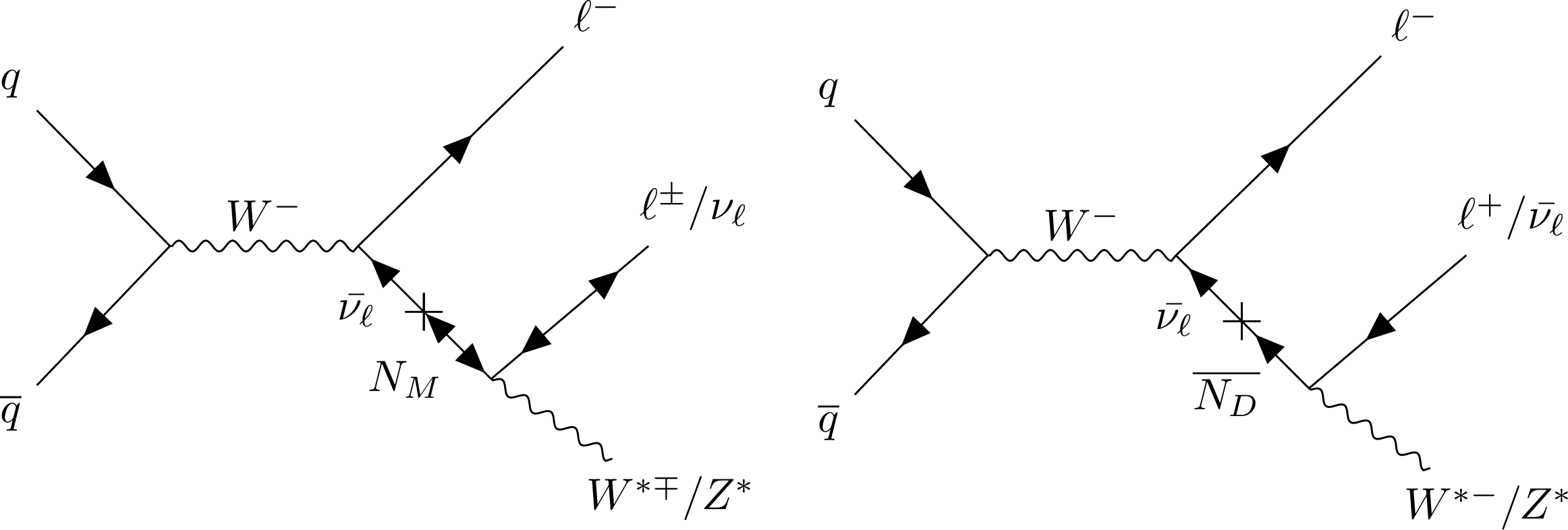
png pdf |
Figure 1:
Feynman diagrams for the production of a Majorana HNL $ N_M $ (left) and a Dirac HNL $ \overline{N_D} $ (right) via a $ \mathrm{W^-} $ boson decay and through its mixing with an SM neutrino of the same flavor. The prompt lepton from the $ \mathrm{W^-} $ boson serves as a clean signature for triggering, whereas the decay products of the HNL are reconstructed as a cluster of muon detector hits. |
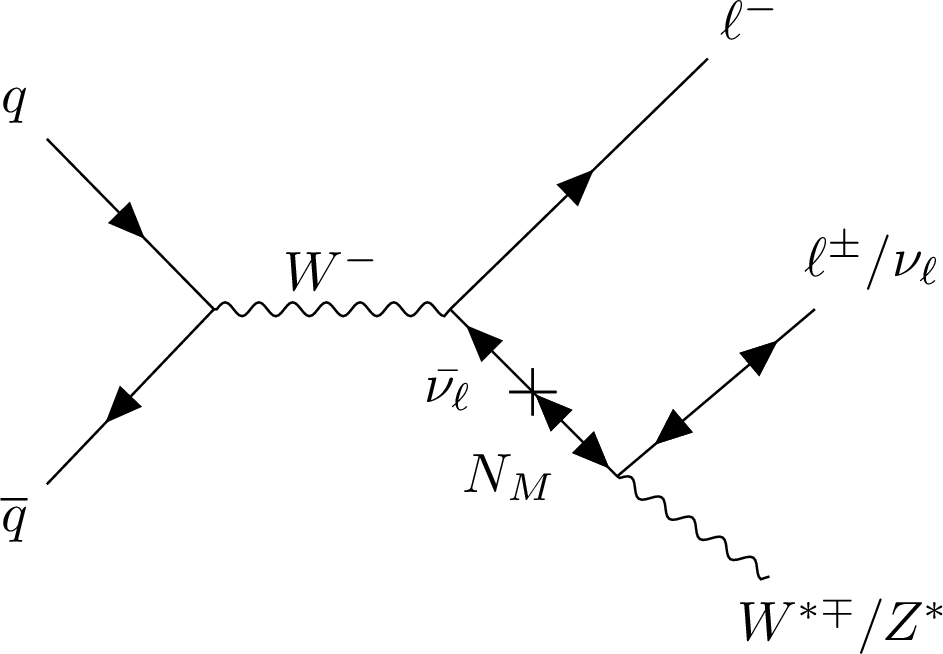
png pdf |
Figure 1-a:
Feynman diagrams for the production of a Majorana HNL $ N_M $ (left) and a Dirac HNL $ \overline{N_D} $ (right) via a $ \mathrm{W^-} $ boson decay and through its mixing with an SM neutrino of the same flavor. The prompt lepton from the $ \mathrm{W^-} $ boson serves as a clean signature for triggering, whereas the decay products of the HNL are reconstructed as a cluster of muon detector hits. |
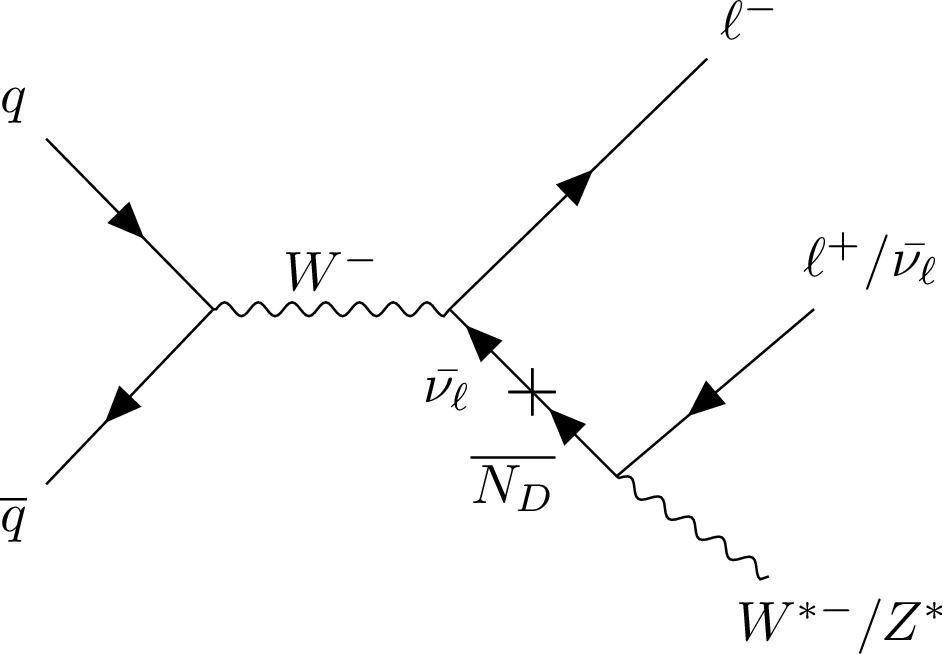
png pdf |
Figure 1-b:
Feynman diagrams for the production of a Majorana HNL $ N_M $ (left) and a Dirac HNL $ \overline{N_D} $ (right) via a $ \mathrm{W^-} $ boson decay and through its mixing with an SM neutrino of the same flavor. The prompt lepton from the $ \mathrm{W^-} $ boson serves as a clean signature for triggering, whereas the decay products of the HNL are reconstructed as a cluster of muon detector hits. |
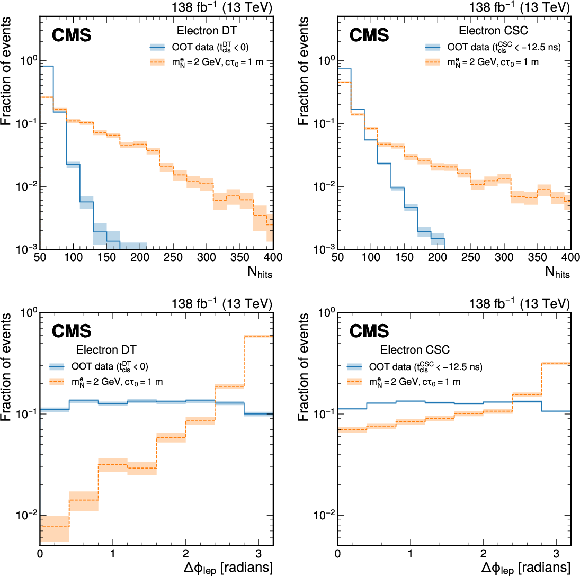
png pdf |
Figure 2:
Distribution of $ N_{\text{hits}} $ (upper) and $ \Delta\phi_\text{lep} $ (lower) for DT clusters (left) and CSC clusters (right). Signal distributions of a Majorana HNL with $ m_{\mathrm{N}} = $ 2 GeV and $ c\tau_{0}= $ 1 m are compared with the OOT background distributions selected with $ t_\mathrm{cluster}^\mathrm{DT} $ matched to bunch crossings earlier than the PV for DT clusters and $ t_\mathrm{cluster}^\mathrm{CSC} < - $12.5 ns for CSC clusters. The centroids of the clusters in the signal events are required to be within $ \Delta R= $ 0.4 of the HNL's direction. The distributions are normalized to unit area. The shapes of the distributions shown are similar for the electron and muon channels. |

png pdf |
Figure 3:
Definition of the ABCD plane. The area of the blue squares illustrates the relative amount of expected events in each of the bins, with bins B and C having the majority of the event yields. Bin D is the signal region. |

png pdf |
Figure 4:
Comparison of $ N_{\text{hits}} $ distributions for events with muons from $ \mathrm{Z}\to\mu\mu $ between data and simulation, for CSC clusters (left) and DT clusters (right), using data collected in 2017 and the simulation of the corresponding data-taking conditions. The data sample is selected by requiring a two-muon invariant mass consistent with a Z boson and one of the muons is matched to an MDS cluster. Data-to-simulation correction factors are applied to the $ \mathrm{Z}\to\mu\mu $ simulation. Only statistical uncertainties are included in the figure. Distributions made using data collected in 2016 and 2018 are found to have similar shape as the 2017 data sample. |
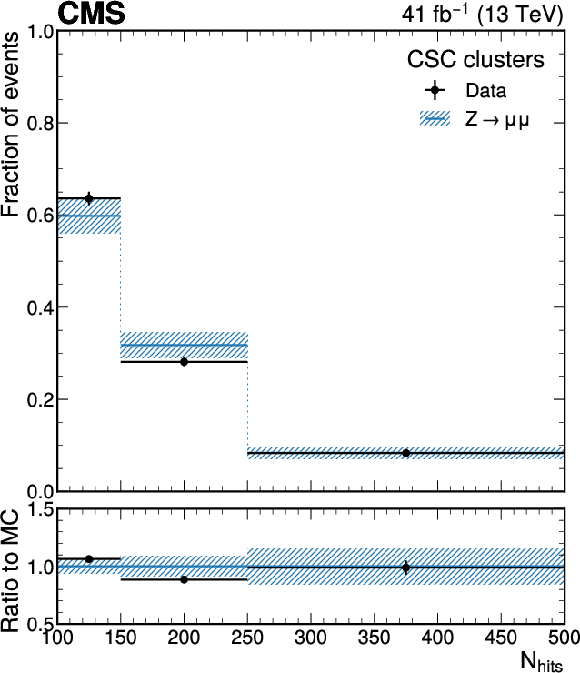
png pdf |
Figure 4-a:
Comparison of $ N_{\text{hits}} $ distributions for events with muons from $ \mathrm{Z}\to\mu\mu $ between data and simulation, for CSC clusters (left) and DT clusters (right), using data collected in 2017 and the simulation of the corresponding data-taking conditions. The data sample is selected by requiring a two-muon invariant mass consistent with a Z boson and one of the muons is matched to an MDS cluster. Data-to-simulation correction factors are applied to the $ \mathrm{Z}\to\mu\mu $ simulation. Only statistical uncertainties are included in the figure. Distributions made using data collected in 2016 and 2018 are found to have similar shape as the 2017 data sample. |
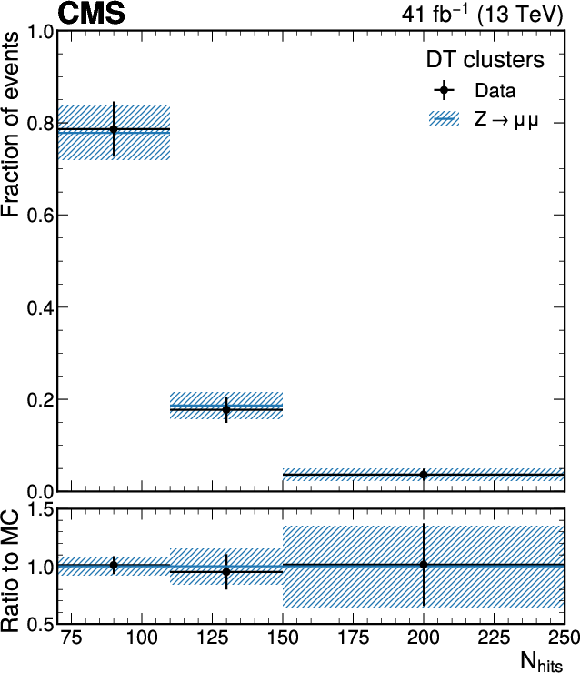
png pdf |
Figure 4-b:
Comparison of $ N_{\text{hits}} $ distributions for events with muons from $ \mathrm{Z}\to\mu\mu $ between data and simulation, for CSC clusters (left) and DT clusters (right), using data collected in 2017 and the simulation of the corresponding data-taking conditions. The data sample is selected by requiring a two-muon invariant mass consistent with a Z boson and one of the muons is matched to an MDS cluster. Data-to-simulation correction factors are applied to the $ \mathrm{Z}\to\mu\mu $ simulation. Only statistical uncertainties are included in the figure. Distributions made using data collected in 2016 and 2018 are found to have similar shape as the 2017 data sample. |

png pdf |
Figure 5:
The expected and observed number of events in the signal region (bin D) of different event categories. Signal yields of a 2 GeV Majorana HNL with the mean proper decay length of 1 m are added to the expected background. |

png pdf |
Figure 6:
Expected and observed upper 95% CL limits on $ |V_{{\mathrm{N}} \mathrm{e}}|^2 $ (upper), $ |V_{{\mathrm{N}} \mu}|^2 $ (middle) and $ |V_{{\mathrm{N}} \tau}|^2 $ (lower) as functions of the HNL mass ($ m_{\mathrm{N}} $) for a Majorana (left) and Dirac (right) type HNL. The $ \tau $ neutrino mixing limit is obtained by combining the results from the electron and muon channels. For these limit calculations, the HNL is assumed to mix with a single lepton flavor state only. The differences between the expected and observed limits on $ |V_{{\mathrm{N}} \mu}|^2 $ are not visible in this figure. |

png pdf |
Figure 6-a:
Expected and observed upper 95% CL limits on $ |V_{{\mathrm{N}} \mathrm{e}}|^2 $ (upper), $ |V_{{\mathrm{N}} \mu}|^2 $ (middle) and $ |V_{{\mathrm{N}} \tau}|^2 $ (lower) as functions of the HNL mass ($ m_{\mathrm{N}} $) for a Majorana (left) and Dirac (right) type HNL. The $ \tau $ neutrino mixing limit is obtained by combining the results from the electron and muon channels. For these limit calculations, the HNL is assumed to mix with a single lepton flavor state only. The differences between the expected and observed limits on $ |V_{{\mathrm{N}} \mu}|^2 $ are not visible in this figure. |

png pdf |
Figure 6-b:
Expected and observed upper 95% CL limits on $ |V_{{\mathrm{N}} \mathrm{e}}|^2 $ (upper), $ |V_{{\mathrm{N}} \mu}|^2 $ (middle) and $ |V_{{\mathrm{N}} \tau}|^2 $ (lower) as functions of the HNL mass ($ m_{\mathrm{N}} $) for a Majorana (left) and Dirac (right) type HNL. The $ \tau $ neutrino mixing limit is obtained by combining the results from the electron and muon channels. For these limit calculations, the HNL is assumed to mix with a single lepton flavor state only. The differences between the expected and observed limits on $ |V_{{\mathrm{N}} \mu}|^2 $ are not visible in this figure. |

png pdf |
Figure 6-c:
Expected and observed upper 95% CL limits on $ |V_{{\mathrm{N}} \mathrm{e}}|^2 $ (upper), $ |V_{{\mathrm{N}} \mu}|^2 $ (middle) and $ |V_{{\mathrm{N}} \tau}|^2 $ (lower) as functions of the HNL mass ($ m_{\mathrm{N}} $) for a Majorana (left) and Dirac (right) type HNL. The $ \tau $ neutrino mixing limit is obtained by combining the results from the electron and muon channels. For these limit calculations, the HNL is assumed to mix with a single lepton flavor state only. The differences between the expected and observed limits on $ |V_{{\mathrm{N}} \mu}|^2 $ are not visible in this figure. |

png pdf |
Figure 6-d:
Expected and observed upper 95% CL limits on $ |V_{{\mathrm{N}} \mathrm{e}}|^2 $ (upper), $ |V_{{\mathrm{N}} \mu}|^2 $ (middle) and $ |V_{{\mathrm{N}} \tau}|^2 $ (lower) as functions of the HNL mass ($ m_{\mathrm{N}} $) for a Majorana (left) and Dirac (right) type HNL. The $ \tau $ neutrino mixing limit is obtained by combining the results from the electron and muon channels. For these limit calculations, the HNL is assumed to mix with a single lepton flavor state only. The differences between the expected and observed limits on $ |V_{{\mathrm{N}} \mu}|^2 $ are not visible in this figure. |
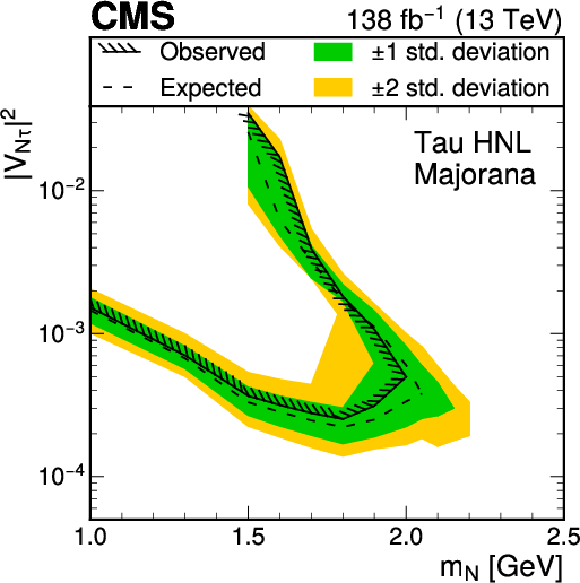
png pdf |
Figure 6-e:
Expected and observed upper 95% CL limits on $ |V_{{\mathrm{N}} \mathrm{e}}|^2 $ (upper), $ |V_{{\mathrm{N}} \mu}|^2 $ (middle) and $ |V_{{\mathrm{N}} \tau}|^2 $ (lower) as functions of the HNL mass ($ m_{\mathrm{N}} $) for a Majorana (left) and Dirac (right) type HNL. The $ \tau $ neutrino mixing limit is obtained by combining the results from the electron and muon channels. For these limit calculations, the HNL is assumed to mix with a single lepton flavor state only. The differences between the expected and observed limits on $ |V_{{\mathrm{N}} \mu}|^2 $ are not visible in this figure. |

png pdf |
Figure 6-f:
Expected and observed upper 95% CL limits on $ |V_{{\mathrm{N}} \mathrm{e}}|^2 $ (upper), $ |V_{{\mathrm{N}} \mu}|^2 $ (middle) and $ |V_{{\mathrm{N}} \tau}|^2 $ (lower) as functions of the HNL mass ($ m_{\mathrm{N}} $) for a Majorana (left) and Dirac (right) type HNL. The $ \tau $ neutrino mixing limit is obtained by combining the results from the electron and muon channels. For these limit calculations, the HNL is assumed to mix with a single lepton flavor state only. The differences between the expected and observed limits on $ |V_{{\mathrm{N}} \mu}|^2 $ are not visible in this figure. |
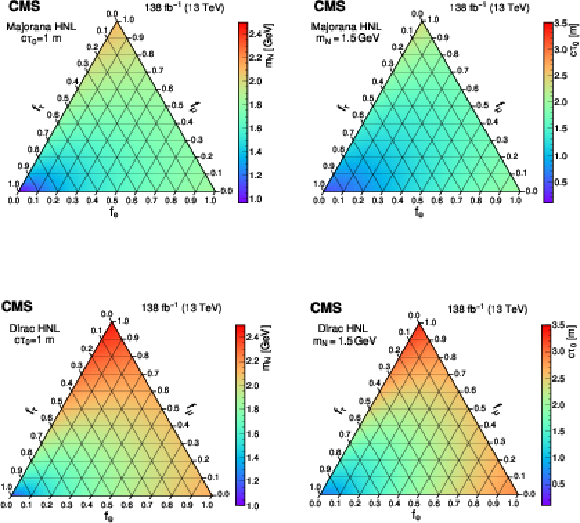
png pdf |
Figure 7:
The largest values of the Majorana (upper) and Dirac (lower) HNL mass (left) and mean proper decay length (right) parameters that are excluded at 95% CL are shown as a function of the mixing matrix elements squared ratios $ f_\ell $ with the three lepton generations, considering a mean proper decay length of 1 m and a fixed mass of 1.5 GeV, respectively. |
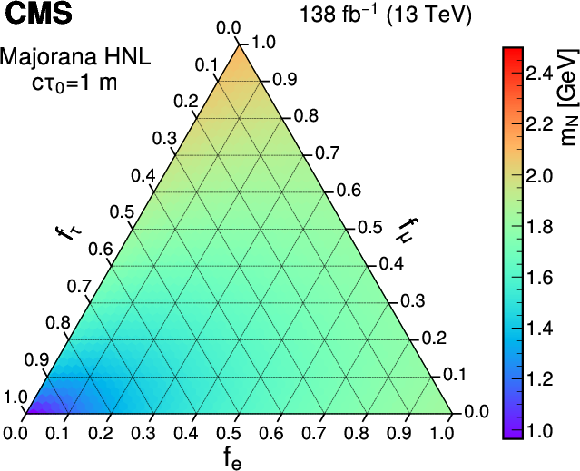
png pdf |
Figure 7-a:
The largest values of the Majorana (upper) and Dirac (lower) HNL mass (left) and mean proper decay length (right) parameters that are excluded at 95% CL are shown as a function of the mixing matrix elements squared ratios $ f_\ell $ with the three lepton generations, considering a mean proper decay length of 1 m and a fixed mass of 1.5 GeV, respectively. |
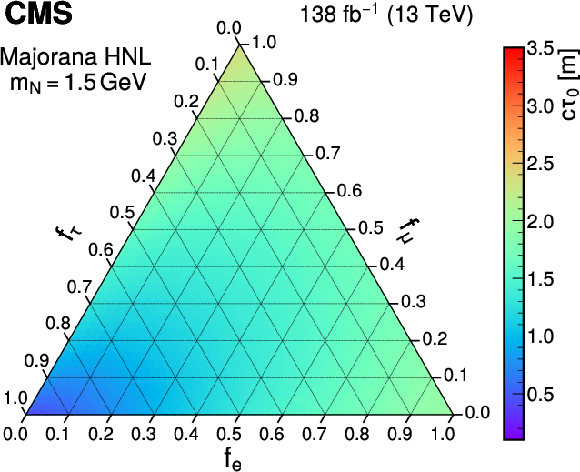
png pdf |
Figure 7-b:
The largest values of the Majorana (upper) and Dirac (lower) HNL mass (left) and mean proper decay length (right) parameters that are excluded at 95% CL are shown as a function of the mixing matrix elements squared ratios $ f_\ell $ with the three lepton generations, considering a mean proper decay length of 1 m and a fixed mass of 1.5 GeV, respectively. |
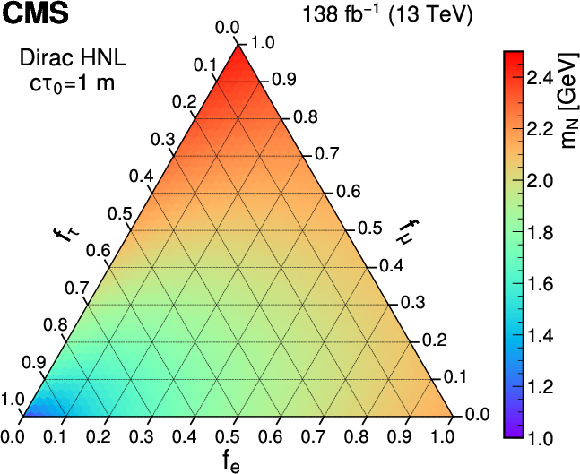
png pdf |
Figure 7-c:
The largest values of the Majorana (upper) and Dirac (lower) HNL mass (left) and mean proper decay length (right) parameters that are excluded at 95% CL are shown as a function of the mixing matrix elements squared ratios $ f_\ell $ with the three lepton generations, considering a mean proper decay length of 1 m and a fixed mass of 1.5 GeV, respectively. |
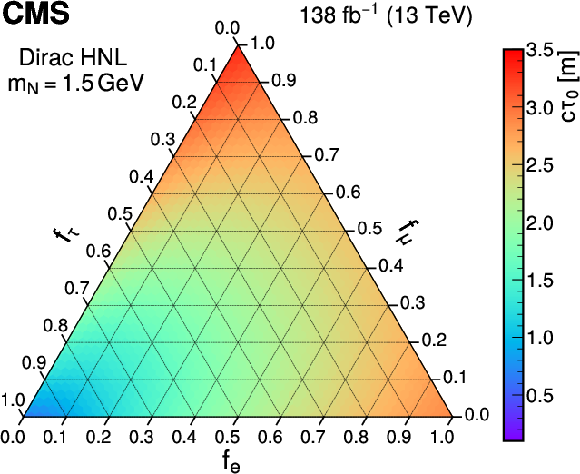
png pdf |
Figure 7-d:
The largest values of the Majorana (upper) and Dirac (lower) HNL mass (left) and mean proper decay length (right) parameters that are excluded at 95% CL are shown as a function of the mixing matrix elements squared ratios $ f_\ell $ with the three lepton generations, considering a mean proper decay length of 1 m and a fixed mass of 1.5 GeV, respectively. |
| Tables | |
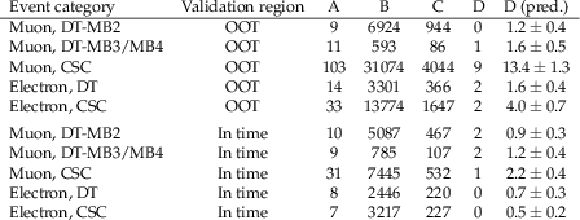
png pdf |
Table 1:
Validation of the ABCD method in the OOT and in-time validation regions. The predictions of the method for the signal bin (last column) are consistent with the observed number of events, shown in the second-to-last column. |

png pdf |
Table 2:
The event yields in the bins A, B, and C are shown in each of the event categories considered in the search, as well as the prefit prediction for the ABCD background in the signal-enriched bin D. |

png pdf |
Table 3:
Summary of the $ \mathrm{Z}\to\mu\mu $ background estimate in different categories. The first three columns show the estimates in the $ \mathrm{Z}\to\mu\mu $ enriched control region of the total background and its $ \mathrm{Z}\to\mu\mu $ and non-muon-induced components. The fourth column shows the transfer factors $ \zeta $ used to predict the $ \mathrm{Z}\to\mu\mu $ background in the signal region, shown in the fifth column. |
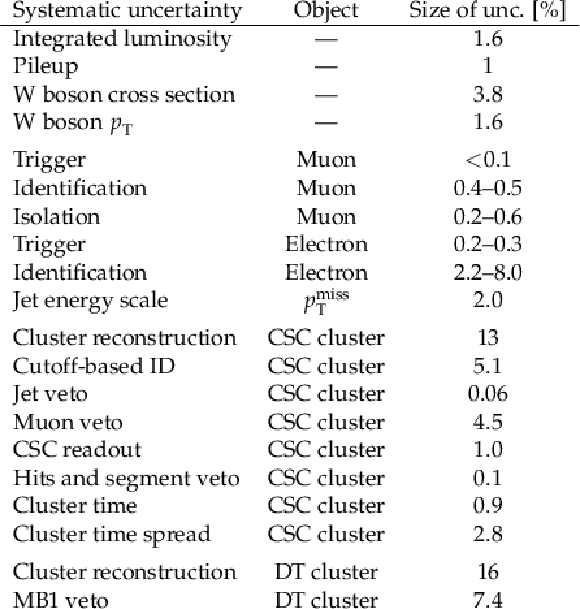
png pdf |
Table 4:
Summary of systematic uncertainties affecting the signal yield prediction. For DT clusters, the systematic uncertainties due to jet and muon vetoes are found to be negligible and are omitted. The uncertainties are reported relative to their impact on the predicted signal yield. |

png pdf |
Table 5:
Excluded ranges of $ |V_{{\mathrm{N}} \ell}|^2 $ for Majorana and Dirac type HNLs at select HNL masses. The chosen HNL masses are those at which the excluded values of $ |V_{{\mathrm{N}} \ell}|^2 $ have the smallest magnitude. |
| Summary |
| A search for long-lived Dirac or Majorana heavy neutral leptons (HNLs) has been performed using proton-proton collision data at $ \sqrt{s} = $ 13 TeV, corresponding to an integrated luminosity of 138 fb$ ^{-1} $. The search targets events with one prompt electron or muon and a muon detector shower (MDS) that would result from HNL decays occurring in the CMS muon detector. The presence of the MDS signature along with the associated vetoes and identification criteria suppresses the standard model background by a factor exceeding 10$^{7} $, while maintaining typical signal efficiencies of 25-35%. No significant excess over the standard model background is observed. The results are interpreted as 95% confidence level limits on the HNL mixing matrix elements squared $ |V_{{\mathrm{N}} \mathrm{e}}|^2 $, $ |V_{{\mathrm{N}} \mu}|^2 $, and $ |V_{{\mathrm{N}} \tau}|^2 $. We also present limits on the HNL mass and mean proper decay length as a function of the mixing matrix element squared fractions to the three lepton generations. The most stringent limits to date for HNLs in the mass range of 2.1-3.0 (1.9-3.3) GeV are set, reaching squared mixing matrix element values as low as 8.6 (4.6) $\times$ 10$^{-6} $ in the electron (muon) channel. |
| Additional Figures | |

png pdf |
Additional Figure 1:
Expected and observed upper 95% confidence level (CL) limits on Majorana HNL production as a function of the HNL mass ($ m_{ \mathrm{N}} $) and coupling strengths on pure muon coupling. Results from previous CMS searches [41,38], as well as other experiments, including ATLAS [35], BEBC [27], Belle [31], CHARM [28], DELPHI [29] and NuTeV [30], are shown as reference. The limits from ATLAS, CMS and DELPHI experiments are set at 95% CL, and the other shown limits are set at 90% CL. The hatched side of the lines indicate regions excluded by the other experiments. |
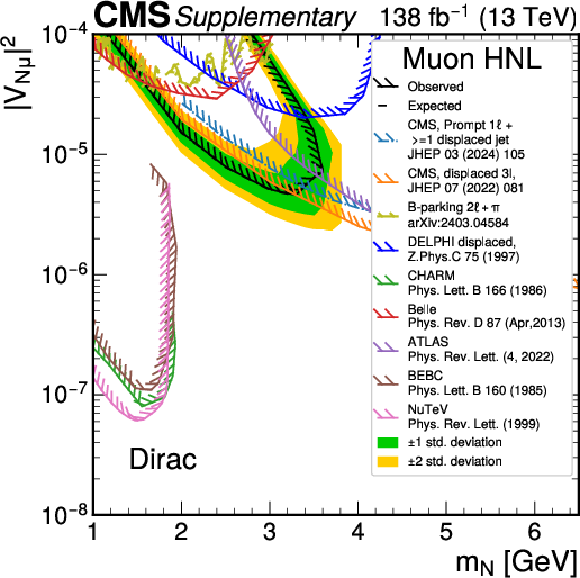
png pdf |
Additional Figure 2:
Expected and observed upper 95% confidence level (CL) limits on Dirac HNL production as a function of the HNL mass ($ m_{ \mathrm{N}} $) and coupling strengths on pure muon coupling. Results from previous CMS searches [41,38], as well as other experiments, including ATLAS [35], BEBC [27], Belle [31], CHARM [28], DELPHI [29] and NuTeV [30], are shown as reference. The limits from ATLAS, CMS and DELPHI experiments are set at 95% CL, and the other shown limits are set at 90% CL. The hatched side of the lines indicate regions excluded by the other experiments. |
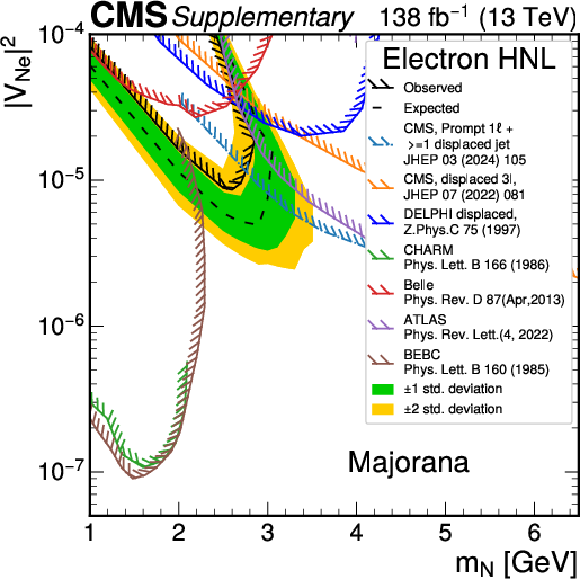
png pdf |
Additional Figure 3:
Expected and observed upper 95% confidence level (CL) limits on Majorana HNL production as a function of the HNL mass ($ m_{ \mathrm{N}} $) and coupling strengths on pure electron coupling. Results from previous CMS searches [41,38], as well as other experiments, including ATLAS [35], BEBC [27], Belle [31], CHARM [28] and DELPHI [29], are shown as reference. The limits from ATLAS, CMS and DELPHI experiments are set at 95% CL, and the other shown limits are set at 90% CL. The hatched side of the lines indicate regions excluded by the other experiments. |
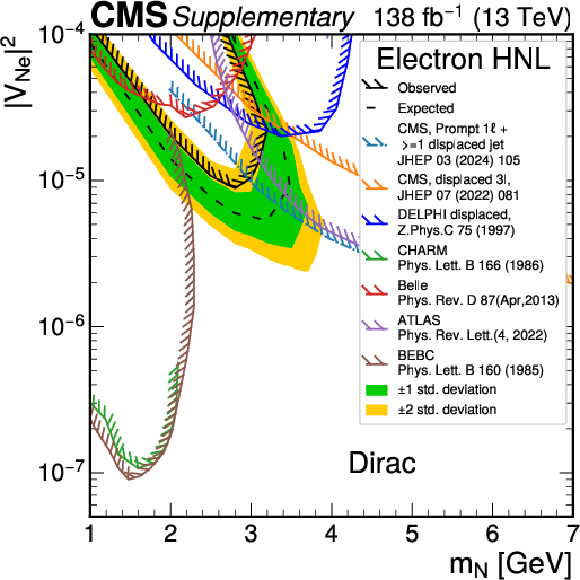
png pdf |
Additional Figure 4:
Expected and observed upper 95% confidence level (CL) limits on Dirac HNL production as a function of the HNL mass ($ m_{ \mathrm{N}} $) and coupling strengths on pure electron coupling. Results from previous CMS searches [41,38], as well as other experiments, including ATLAS [35], BEBC [27], Belle [31], CHARM [28] and DELPHI [29], are shown as reference. The limits from ATLAS, CMS and DELPHI experiments are set at 95% CL, and the other shown limits are set at 90% CL. The hatched side of the lines indicate regions excluded by the other experiments. |
| References | ||||
| 1 | Super-Kamiokande Collaboration | Evidence for oscillation of atmospheric neutrinos | PRL 81 (1998) 1562 | hep-ex/9807003 |
| 2 | SNO Collaboration | Direct evidence for neutrino flavor transformation from neutral-current interactions in the Sudbury Neutrino Observatory | PRL 89 (2002) 011301 | nucl-ex/0204008 |
| 3 | KamLAND Collaboration | First results from KamLAND: Evidence for reactor antineutrino disappearance | PRL 90 (2003) 021802 | hep-ex/0212021 |
| 4 | S. Bilenky | Neutrino oscillations: From a historical perspective to the present status | NPB 908 (2016) 2 | 1602.00170 |
| 5 | S. Roy Choudhury and S. Hannestad | Updated results on neutrino mass and mass hierarchy from cosmology with Planck 2018 likelihoods | JCAP 07 (2020) 037 | 1907.12598 |
| 6 | M. Ivanov, M. Simonović , and M. Zaldarriaga | Cosmological parameters and neutrino masses from the final Planck and full-shape BOSS data | PRD 101 (2020) 083504 | 1912.08208 |
| 7 | J. Formaggio, A. de Gouvêa, and R. Robertson | Direct measurements of neutrino mass | Phys. Rept. 914 (2021) 1 | 2102.00594 |
| 8 | P. Minkowski | $ {\mu\to\mathrm{e}\gamma} $ at a rate of one out of $ 10^{9} $ muon decays? | PLB 67 (1977) 421 | |
| 9 | T. Yanagida | Horizontal symmetry and masses of neutrinos | Prog. of Theo. Phys. 64 (1980) 1103 | |
| 10 | M. Gell-Mann, P. Ramond, and R. Slansky | Complex spinors and unified theories | in Supergravity, North Holland Publishing, 1979 | 1306.4669 |
| 11 | S. Glashow | The future of elementary particle physics | NATO Sci. Ser. B 61 (1980) 687 | |
| 12 | R. N. Mohapatra and G. Senjanović | Neutrino mass and spontaneous parity nonconservation | PRL 44 (1980) 912 | |
| 13 | J. Schechter and J. W. F. Valle | Neutrino masses in $ \mathrm{SU}(2)\otimes\mathrm{U}(1) $ theories | PRD 22 (1980) 2227 | |
| 14 | R. E. Shrock | General theory of weak leptonic and semileptonic decays. I. Leptonic pseudoscalar meson decays, with associated tests for, and bounds on, neutrino masses and lepton mixing | PRD 24 (1981) 1232 | |
| 15 | Y. Cai, T. Han, T. Li, and R. Ruiz | Lepton number violation: Seesaw models and their collider tests | Front. Phys. 6 (2018) 40 | 1711.02180 |
| 16 | Z. Maki, M. Nakagawa, and S. Sakata | Remarks on the unified model of elementary particles | Prog. Theor. Phys. 28 (1962) 870 | |
| 17 | B. Pontecorvo | Neutrino experiments and the problem of conservation of leptonic charge | Zh. Eksp. Teor. Fiz. 53 (1967) 1717 | |
| 18 | A. Das, P. Konar, and S. Majhi | Production of Heavy neutrino in next-to-leading order QCD at the LHC and beyond | JHEP 06 (2016) 019 | 1604.00608 |
| 19 | A. Das and N. Okada | Bounds on heavy Majorana neutrinos in type-I seesaw and implications for collider searches | PLB 774 (2017) 32 | 1702.04668 |
| 20 | G. Cottin et al. | Long-lived heavy neutral leptons with a displaced shower signature at CMS | JHEP 02 (2023) 011 | 2210.17446 |
| 21 | K. Bondarenko, A. Boyarsky, D. Gorbunov, and O. Ruchayskiy | Phenomenology of GeVns-scale heavy neutral leptons | JHEP 11 (2018) 032 | 1805.08567 |
| 22 | M. Fukugita and T. Yanagida | Baryogenesis without grand unification | PLB 174 (1986) 45 | |
| 23 | E. Chun et al. | Probing leptogenesis | Int. J. Mod. Phys. A 33 (2018) 1842005 | 1711.02865 |
| 24 | A. Boyarsky et al. | Sterile neutrino dark matter | Prog. Part. Nucl. Phys. 104 (2019) 1 | |
| 25 | V. Cirigliano et al. | Leptonic anomalous magnetic moments in $\nu $SMEFT | JHEP 08 (2021) 103 | 2105.11462 |
| 26 | Muon g${-}$2 Collaboration | Measurement of the Positive Muon Anomalous Magnetic Moment to 0.20 ppm | PRL 131 (2023) 161802 | 2308.06230 |
| 27 | WA66 Collaboration | Search for heavy neutrino decays in the BEBC beam dump experiment | PLB 160 (1985) 207 | |
| 28 | CHARM Collaboration | A search for decays of heavy neutrinos in the mass range 0.5-2.8 GeV | PLB 166 (1986) 473 | |
| 29 | DELPHI Collaboration | Search for neutral heavy leptons produced in Z decays | Z. Phys. C 74 (1997) 57 | |
| 30 | NuTeV(E815) Collaboration | Search for neutral heavy leptons in a high-energy neutrino beam | PRL 83 (1999) 4943 | hep-ex/9908011 |
| 31 | Belle Collaboration | Search for heavy neutrinos at Belle | PRD 87 (2013) 071102 | 1301.1105 |
| 32 | F. F. Deppisch, P. S. Bhupal Dev, and A. Pilaftsis | Neutrinos and collider physics | New J. Phys. 17 (2015) 075019 | 1502.06541 |
| 33 | J. Beacham et al. | Physics beyond colliders at CERN: Beyond the standard model working group report | JPG 47 (2020) 010501 | 1901.09966 |
| 34 | ATLAS Collaboration | Search for heavy neutral leptons in decays of W bosons produced in 13 TeV pp collisions using prompt and displaced signatures with the ATLAS detector | JHEP 10 (2019) 265 | 1905.09787 |
| 35 | ATLAS Collaboration | Search for heavy neutral leptons in decays of $ W $ bosons using a dilepton displaced vertex in $ \sqrt{s}= $ 13 TeV pp collisions with the ATLAS detector | PRL 131 (2023) 061803 | 2204.11988 |
| 36 | CMS Collaboration | Search for heavy neutral leptons in events with three charged leptons in proton-proton collisions at $ \sqrt{s} = $ 13 TeV | PRL 120 (2018) 221801 | CMS-EXO-17-012 1802.02965 |
| 37 | CMS Collaboration | Search for heavy Majorana neutrinos in same-sign dilepton channels in proton-proton collisions at $ \sqrt{s}= $ 13 TeV | JHEP 01 (2019) 122 | CMS-EXO-17-028 1806.10905 |
| 38 | CMS Collaboration | Search for long-lived heavy neutral leptons with displaced vertices in proton-proton collisions at $ \sqrt{s}= $ 13 TeV | JHEP 07 (2022) 081 | CMS-EXO-20-009 2201.05578 |
| 39 | LHCb Collaboration | Search for heavy neutral leptons in $ \textrm{W}^+\to\mu^{+}\mu^{\pm}$jet decays | EPJC 81 (2021) 248 | 2011.05263 |
| 40 | LHCb Collaboration | Search for long-lived particles decaying to $ \textrm{e}^\pm \mu^\mp \nu $ | EPJC 81 (2021) 261 | 2012.02696 |
| 41 | CMS Collaboration | Search for long-lived heavy neutral leptons with lepton flavour conserving or violating decays to a jet and a charged lepton | Submitted to JHEP, 2023 | CMS-EXO-21-013 2312.07484 |
| 42 | CMS Collaboration | Search for long-lived particles decaying in the CMS endcap muon detectors in proton-proton collisions at $ \sqrt{s}= $ 13 TeV | PRL 127 (2021) 261804 | CMS-EXO-20-015 2107.04838 |
| 43 | CMS Collaboration | HEPData record for this analysis | link | |
| 44 | CMS Collaboration | Performance of the CMS Drift Tube Chambers with Cosmic Rays | JINST 5 (2010) T03015 | CMS-CFT-09-012 0911.4855 |
| 45 | CMS Collaboration | Performance of the CMS Level-1 trigger in proton-proton collisions at $ \sqrt{s} = $ 13 TeV | JINST 15 (2020) P10017 | CMS-TRG-17-001 2006.10165 |
| 46 | CMS Collaboration | The CMS trigger system | JINST 12 (2017) P01020 | CMS-TRG-12-001 1609.02366 |
| 47 | CMS Collaboration | The CMS experiment at the CERN LHC | JINST 3 (2008) S08004 | |
| 48 | P. Nason | A new method for combining NLO QCD with shower Monte Carlo algorithms | JHEP 11 (2004) 040 | hep-ph/0409146 |
| 49 | S. Frixione, P. Nason, and C. Oleari | Matching NLO QCD computations with parton shower simulations: the POWHEG method | JHEP 11 (2007) 070 | 0709.2092 |
| 50 | S. Alioli, P. Nason, C. Oleari, and E. Re | A general framework for implementing NLO calculations in shower Monte Carlo programs: the POWHEG box | JHEP 06 (2010) 043 | 1002.2581 |
| 51 | R. Gavin, Y. Li, F. Petriello, and S. Quackenbush | FEWZ 2.0: A code for hadronic Z production at next-to-next-to-leading order | Comput. Phys. Commun. 182 (2011) 2388 | 1011.3540 |
| 52 | R. Gavin, Y. Li, F. Petriello, and S. Quackenbush | W physics at the LHC with FEWZ 2.1 | Comput. Phys. Commun. 184 (2013) 208 | 1201.5896 |
| 53 | J. Alwall et al. | The automated computation of tree-level and next-to-leading order differential cross sections, and their matching to parton shower simulations | JHEP 07 (2014) 079 | 1405.0301 |
| 54 | D. Alva, T. Han, and R. Ruiz | Heavy Majorana neutrinos from $ \mathrm{W}\gamma $ fusion at hadron colliders | JHEP 02 (2015) 072 | 1411.7305 |
| 55 | C. Degrande, O. Mattelaer, R. Ruiz, and J. Turner | Fully-automated precision predictions for heavy neutrino production mechanisms at hadron colliders | PRD 94 (2016) 053002 | 1602.06957 |
| 56 | S. Pascoli, R. Ruiz, and C. Weiland | Heavy neutrinos with dynamic jet vetoes: Multilepton searches at $ \sqrt{s}= $ 14, 27, and 100 TeV | JHEP 06 (2019) 049 | 1812.08750 |
| 57 | T. Sjöstrand et al. | An introduction to PYTHIA8.2 | Comp. Phys. Comm. 191 (2015) 159 | 1410.3012 |
| 58 | Y. Li and F. Petriello | Combining QCD and electroweak corrections to dilepton production in FEWZ | PRD 86 (2012) 094034 | 1208.5967 |
| 59 | S. Camarda et al. | DYTurbo: Fast predictions for Drell-Yan processes | EPJC 80 (2020) 251 | 1910.07049 |
| 60 | S. Camarda, L. Cieri, and G. Ferrera | Drell-yan lepton-pair production: $ {q}_{T} $ resummation at $ \mathrm{N}^{3}\mathrm{LL} $ accuracy and fiducial cross sections at $ \mathrm{N}^{3}\mathrm{LO} $ | PRD 104 (2021) L111503 | 2103.04974 |
| 61 | GEANT4 Collaboration | GEANT 4--a simulation toolkit | NIM A 506 (2003) 250 | |
| 62 | CMS Collaboration | Precision luminosity measurement in proton-proton collisions at $ \sqrt{s}= $ 13 TeV in 2015 and 2016 at CMS | EPJC 81 (2021) 800 | CMS-LUM-17-003 2104.01927 |
| 63 | CMS Collaboration | CMS luminosity measurement for the 2017 data-taking period at $ \sqrt{s} = $ 13 TeV | CMS Physics Analysis Summary, 2018 link |
CMS-PAS-LUM-17-004 |
| 64 | CMS Collaboration | CMS luminosity measurement for the 2018 data-taking period at $ \sqrt{s} = $ 13 TeV | CMS Physics Analysis Summary, 2019 link |
CMS-PAS-LUM-18-002 |
| 65 | CMS Collaboration | Event generator tunes obtained from underlying event and multiparton scattering measurements | EPJC 76 (2016) 155 | CMS-GEN-14-001 1512.00815 |
| 66 | CMS Collaboration | Extraction and validation of a new set of CMS PYTHIA8 tunes from underlying-event measurements | EPJC 80 (2020) 4 | CMS-GEN-17-001 1903.12179 |
| 67 | NNPDF Collaboration | Parton distributions for the LHC Run II | JHEP 04 (2015) 040 | 1410.8849 |
| 68 | NNPDF Collaboration | Parton distributions from high-precision collider data | EPJC 77 (2017) 663 | 1706.00428 |
| 69 | CMS Collaboration | Particle-flow reconstruction and global event description with the CMS detector | JINST 12 (2017) P10003 | CMS-PRF-14-001 1706.04965 |
| 70 | CMS Collaboration | Electron and photon reconstruction and identification with the CMS experiment at the CERN LHC | JINST 16 (2021) P05014 | CMS-EGM-17-001 2012.06888 |
| 71 | CMS Collaboration | Performance of the CMS muon detector and muon reconstruction with proton-proton collisions at $ \sqrt{s}= $ 13 TeV | JINST 13 (2018) P06015 | CMS-MUO-16-001 1804.04528 |
| 72 | CMS Collaboration | Performance of photon reconstruction and identification with the CMS detector in proton-proton collisions at $ \sqrt{s} = $ 8 TeV | JINST 10 (2015) P08010 | CMS-EGM-14-001 1502.02702 |
| 73 | M. Cacciari, G. P. Salam, and G. Soyez | The anti-$ k_{\mathrm{T}} $ jet clustering algorithm | JHEP 04 (2008) 063 | 0802.1189 |
| 74 | M. Cacciari, G. P. Salam, and G. Soyez | FASTJET user manual | EPJC 72 (2012) 1896 | 1111.6097 |
| 75 | CMS Collaboration | Pileup mitigation at CMS in 13 TeV data | JINST 15 (2020) P09018 | CMS-JME-18-001 2003.00503 |
| 76 | CMS Collaboration | Jet energy scale and resolution in the CMS experiment in pp collisions at 8 TeV | JINST 12 (2017) P02014 | CMS-JME-13-004 1607.03663 |
| 77 | CMS Collaboration | Performance of missing transverse momentum reconstruction in proton-proton collisions at $ \sqrt{s} = $ 13 TeV using the CMS detector | JINST 14 (2019) P07004 | CMS-JME-17-001 1903.06078 |
| 78 | CMS Collaboration | Technical proposal for the Phase-II upgrade of the Compact Muon Solenoid | CMS Technical Proposal CERN-LHCC-2015-010, CMS-TDR-15-02, 2015 CDS |
|
| 79 | M. Ester, H.-P. Kriegel, J. Sander, and X. Xu | A density-based algorithm for discovering clusters in large spatial databases with noise | in Proc. 2nd Int. Conf. on Knowledge Discovery and Data Mining, Association for the Advancement of Artificial Intelligence, 1996 link |
|
| 80 | CMS Collaboration | Identification of b-quark jets with the CMS experiment | JINST 8 (2013) P04013 | CMS-BTV-12-001 1211.4462 |
| 81 | CMS Collaboration | Identification of heavy-flavour jets with the CMS detector in pp collisions at 13 TeV | JINST 13 (2018) P05011 | CMS-BTV-16-002 1712.07158 |
| 82 | T. Junk | Confidence level computation for combining searches with small statistics | NIM A 434 (1999) 435 | hep-ex/9902006 |
| 83 | A. L. Read | Presentation of search results: the $ \text{CL}_\text{s} $ technique | JPG 28 (2002) 2693 | |
| 84 | ATLAS and CMS Collaborations, and the LHC Higgs Combination Group | Procedure for the LHC Higgs boson search combination in Summer 2011 | Technical Report CMS-NOTE-2011-005, ATL-PHYS-PUB-2011-11, 2011 | |
| 85 | G. Cowan, K. Cranmer, E. Gross, and O. Vitells | Asymptotic formulae for likelihood-based tests of new physics | EPJC 71 (2011) 1554 | 1007.1727 |
| 86 | M. Drewes, J. Klarić, and J. López-Pavón | New benchmark models for heavy neutral lepton searches | EPJC 82 (2022) 1176 | 2207.02742 |

|
Compact Muon Solenoid LHC, CERN |

|

|

|

|

|

|